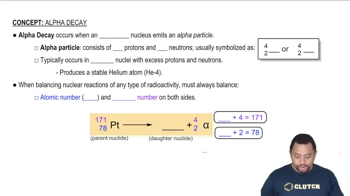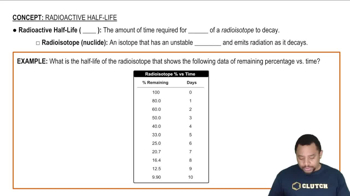Here are the essential concepts you must grasp in order to answer the question correctly.
Nuclear Decay Processes
Nuclear decay processes are the mechanisms by which unstable atomic nuclei lose energy and particles to reach a more stable state. The primary types include alpha emission, where an alpha particle (two protons and two neutrons) is released; beta emission, where a neutron transforms into a proton and emits a beta particle (electron); and electron capture, where an electron is absorbed by a proton, converting it into a neutron.
Recommended video:
Balanced Nuclear Equations
A balanced nuclear equation represents the transformation of an unstable nucleus into a more stable one, ensuring that the total number of protons and neutrons is conserved. In these equations, the sum of atomic numbers (protons) and mass numbers (protons + neutrons) must be equal on both sides of the equation, reflecting the conservation of mass and charge during the decay process.
Recommended video:
Balancing Chemical Equations
Radioisotopes
Radioisotopes are isotopes of elements that are unstable and undergo radioactive decay, emitting radiation in the form of particles or electromagnetic waves. They are characterized by their half-lives, which indicate the time required for half of a sample to decay. Understanding the specific radioisotope, such as 226Ac, is crucial for predicting its decay modes and the resulting products of the decay process.
Recommended video:
Intro to Radioactive Half-Life




